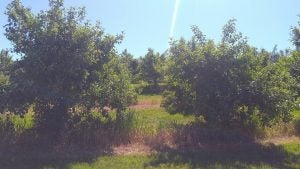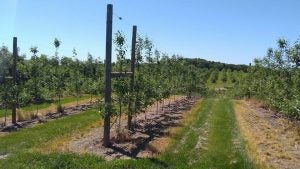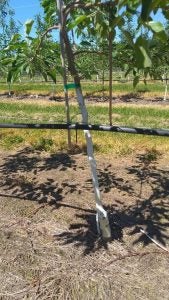They say America loses an acre of farmland per minute to urban development. With that being said, there’s never been a better time to allow technology and improvements in agriculture to allow us to feed everyone more efficiently and more sustainably. Yields need to be maximized while the impact on natural resources must be minimized.
From the late 1800s to today the population has grown by more than 800 percent, and we all need dinner. Do you think farmers will be able to feed 9 billion people by the year 2050? In a world where medical advances are better than ever before, scientists and farmers are doing excellent work to overcome obstacles brought forth by Mother Nature — like fungus, disease, marketability, yields — while being better stewards and using less resources.
Recently I was in the Minneapolis area visiting friends Megan and Jp Jacobson. Jp is a third-generation apple grower at Pine Tree Apple Orchard and was able to share some of the differences of apple growing then and now:
Below is a picture of some of their “Fireside” variety apple trees that were planted back in the ‘60s. Fireside apples back then are equivalent to what Honey Crisp apples are now in terms of popular apple trends with consumers.

As you can see, these trees get pretty big. The problem with these older varieties is that the sun can’t always penetrate the interior of the trees, so right off the bat you can lose about 30 percent of your yields or marketability. The apples that don’t see as much sun won’t get the overall nice coloring that people would look for and can be a little inconsistent.
Another issue is pest management. If growers have to spray for fungus or use pest control products (apple trees are susceptible to scab and pest damage), that spray can fall in between the trees, putting some of the chemical to waste, which hurts their bottom line and the land. But there is a solution!
Behold: Newer varieties of apple trees!

As you can see, these trees are smaller and closer together, which helps to improve the problems listed above. Although these trees are young, they will eventually produce apples that are able to ripen properly, leading to better marketability and yields. Another benefit is harvest. It’s much easier to pick apples when you can practically wrap your arms around the whole tree. Now, pickers won’t have to dig inside of the older trees in the shade. Also these types of trees are more mechanically friendly and you can learn more about the harvest process here.
Another thing to note with the better trees is that they’re on a trellis, which helps with stability and drip irrigation. Instead of the water going everywhere, the water can be better utilized with drip tape, leading to better moisture control and use of natural resources.
Everything a farmer does boils down to a science depending on soil type, variety, and root stock selection, to name a few. To get a better dwarfing tree, scions are grafted to rootstocks to get desired traits. Other traits, such as disease resistance, are selected, which helps growers overcome the nightmares Mother Nature may hand them with pests or disease. Here is a picture of grafting and drip tape irrigation to get an idea of what this looks like:

A couple other fun facts? It typically takes between 7 and 10 years for a standard non-grafted apple tree to bear fruit while grafted dwarf or semi-dwarf trees will bear sooner, usually 3 to 5 years. It takes 25 to 30 leaves to grow an apple. Apples are “thinned” to separate good from great, while an acre of apple trees in an orchard like this can yield about 1,000 bushels per acre. The next time you tour an apple farm, friend the farmer and learn more about the science behind it. It really is fascinating and makes you appreciate your food that much more.
Michelle Miller, the Farm Babe, is an Iowa-based farmer, public speaker and writer, who lives and works with her boyfriend on their farm which consists of row crops, beef cattle, and sheep. She believes education is key in bridging the gap between farmers and consumers.



